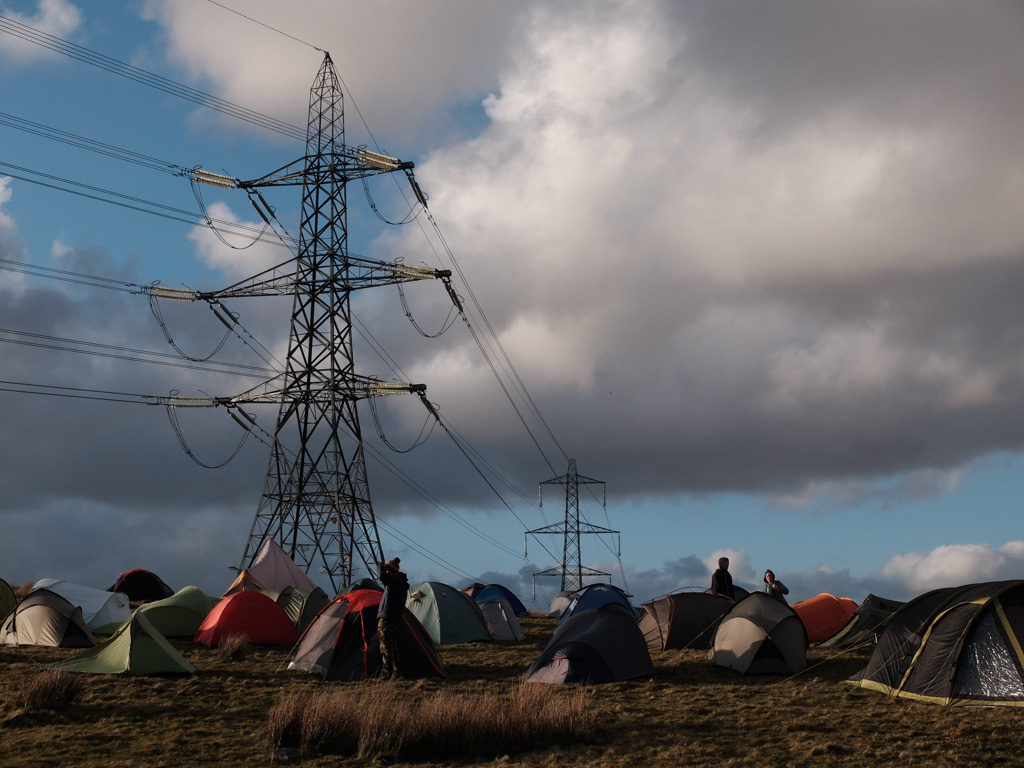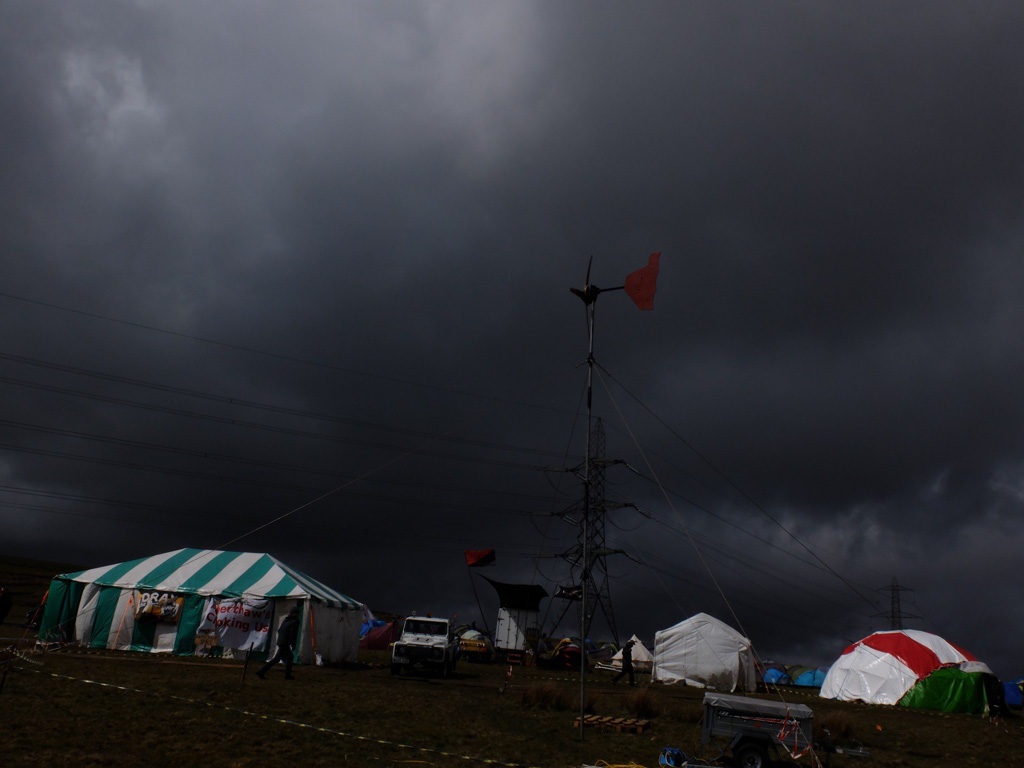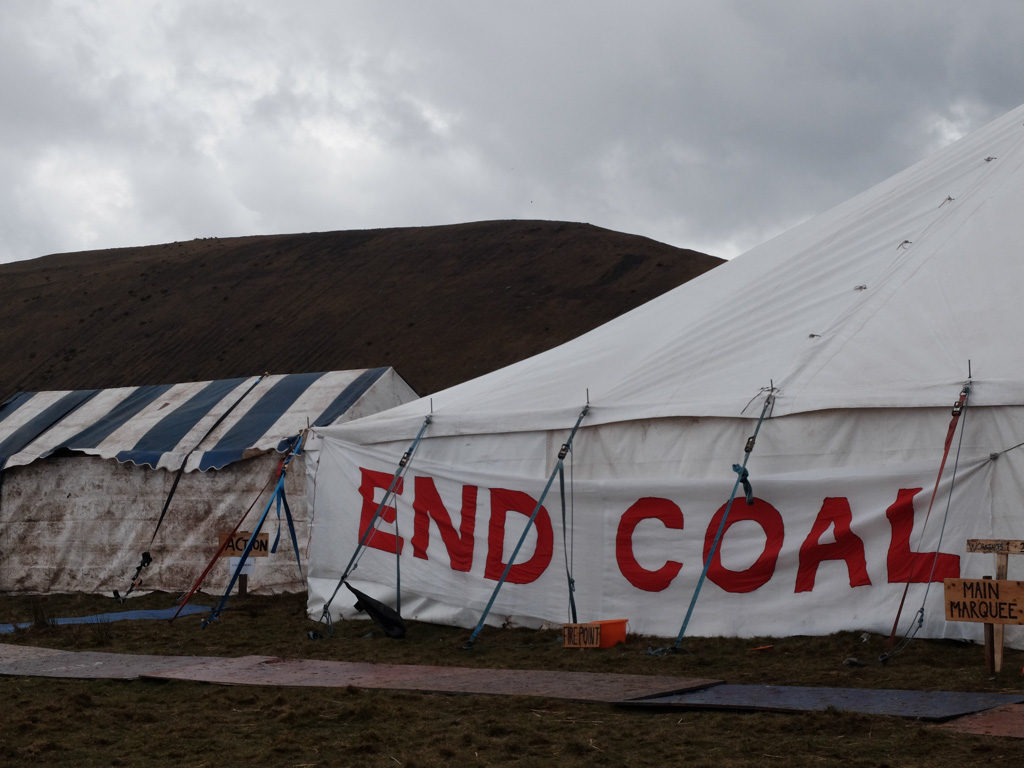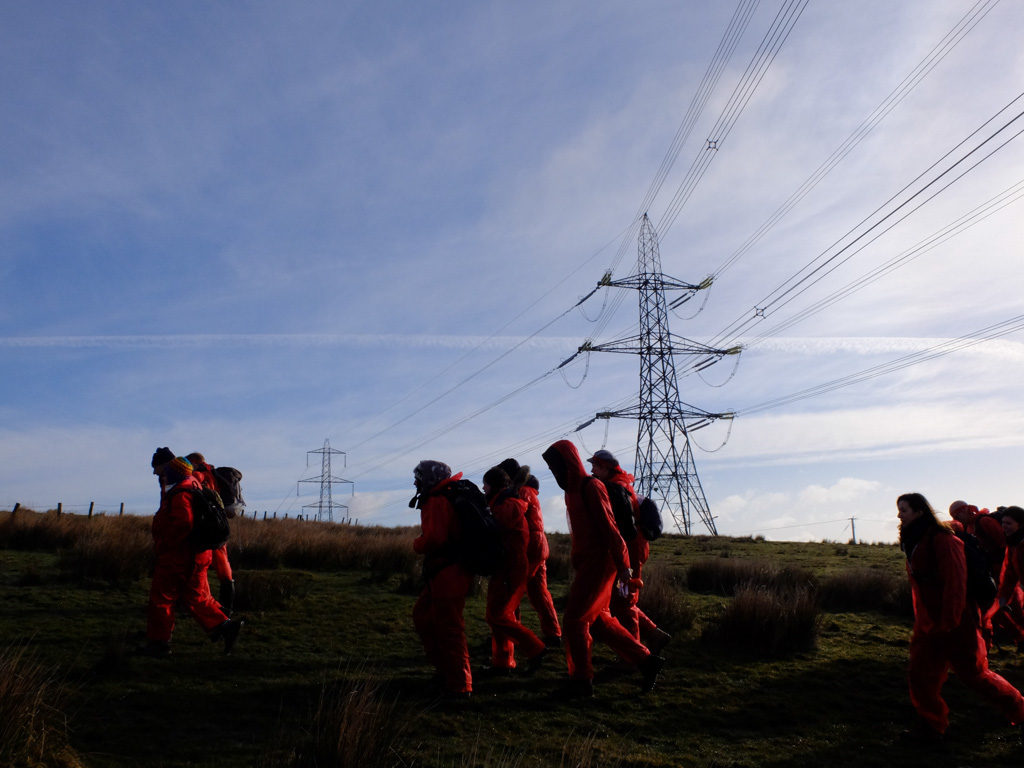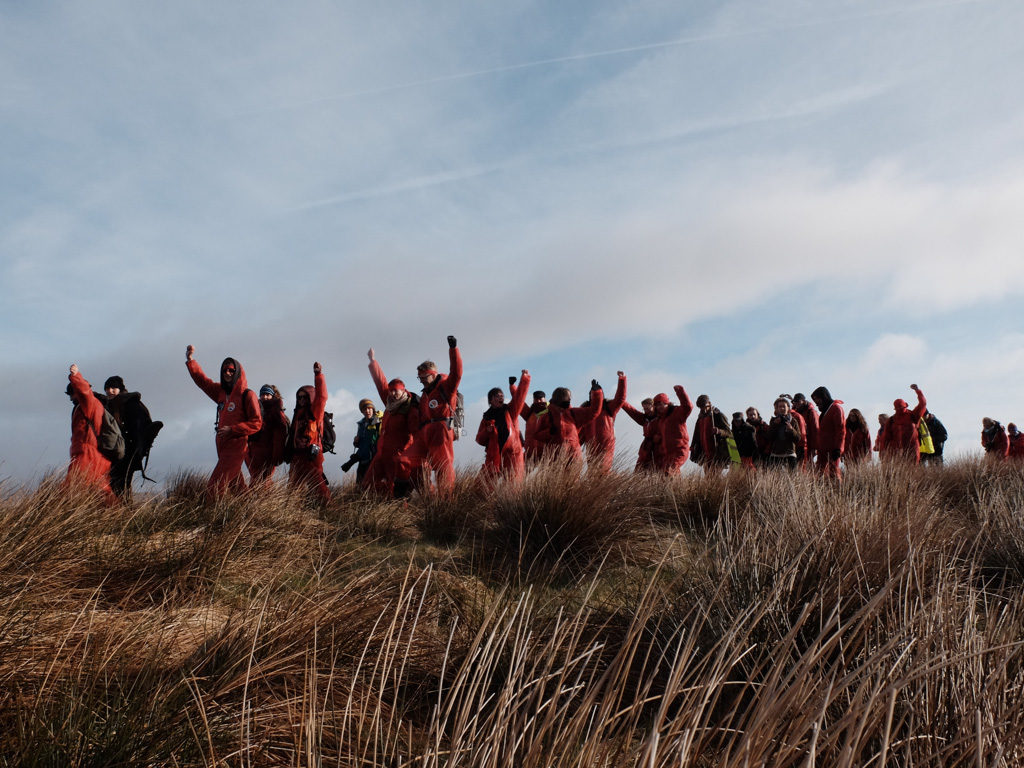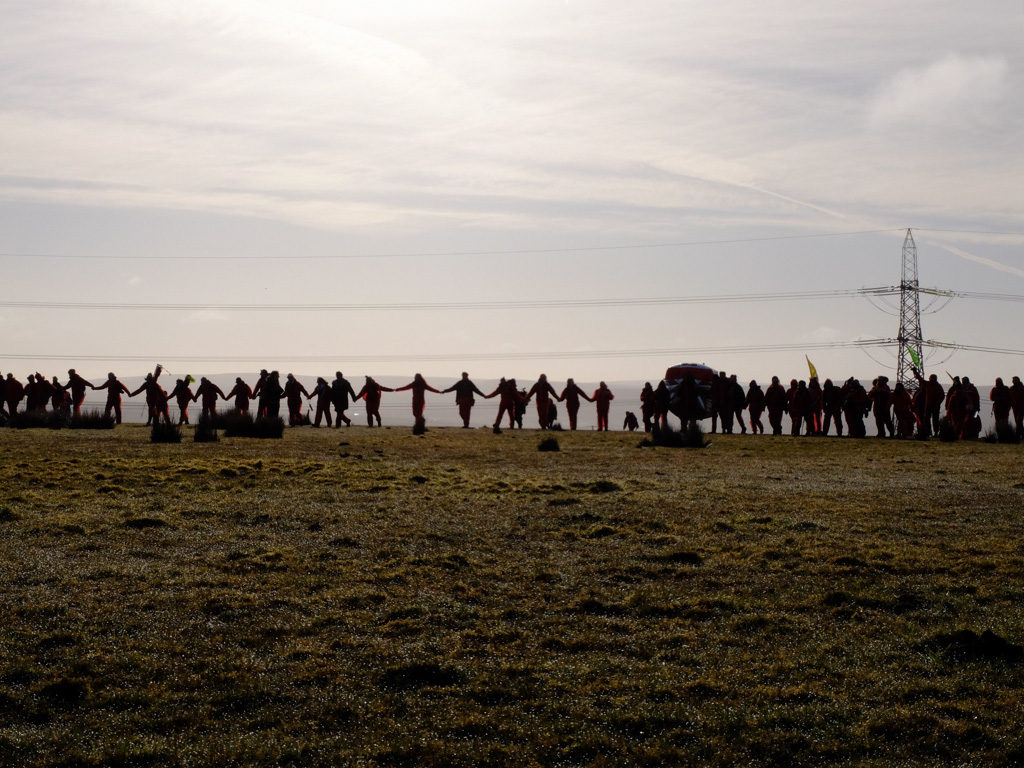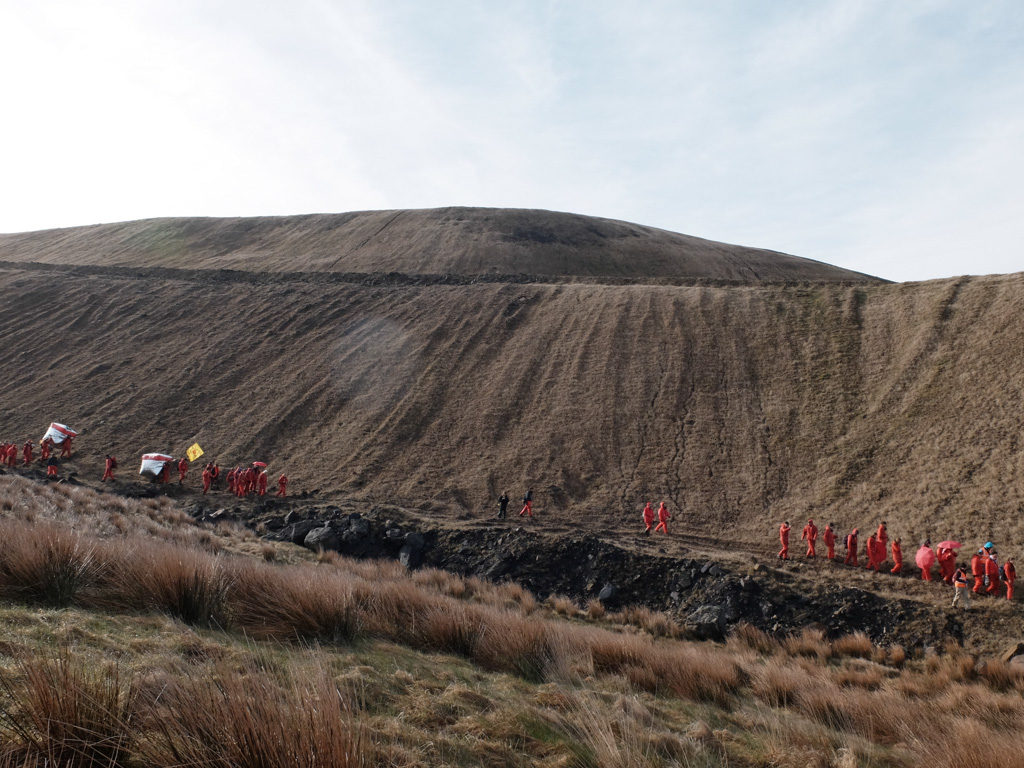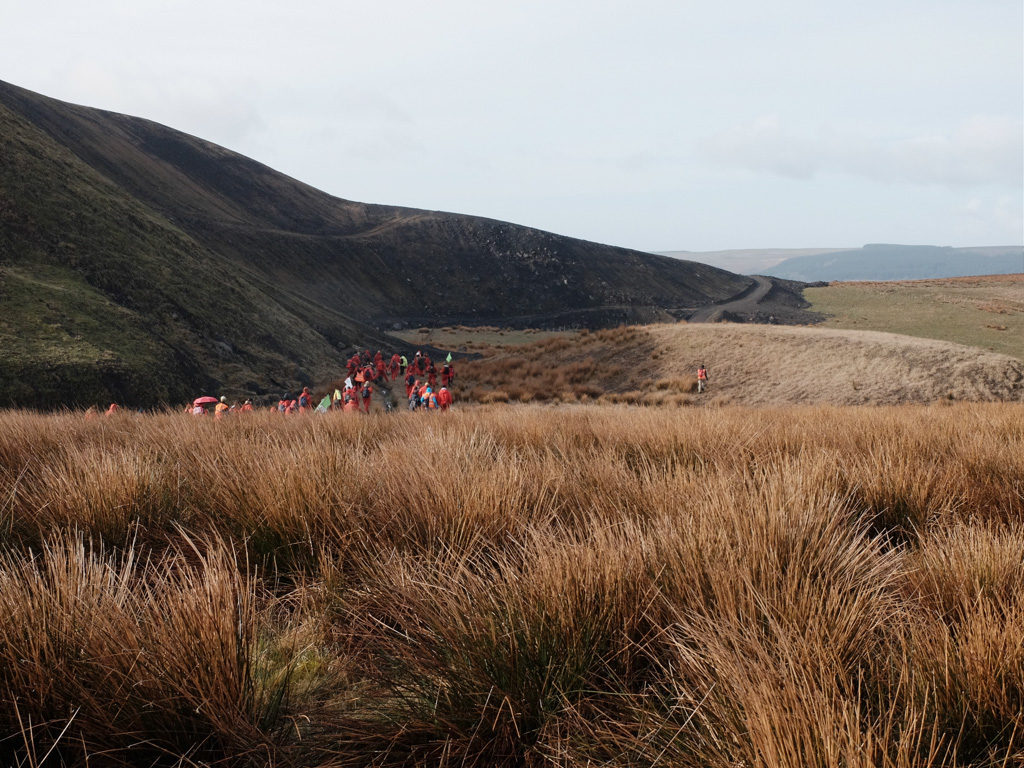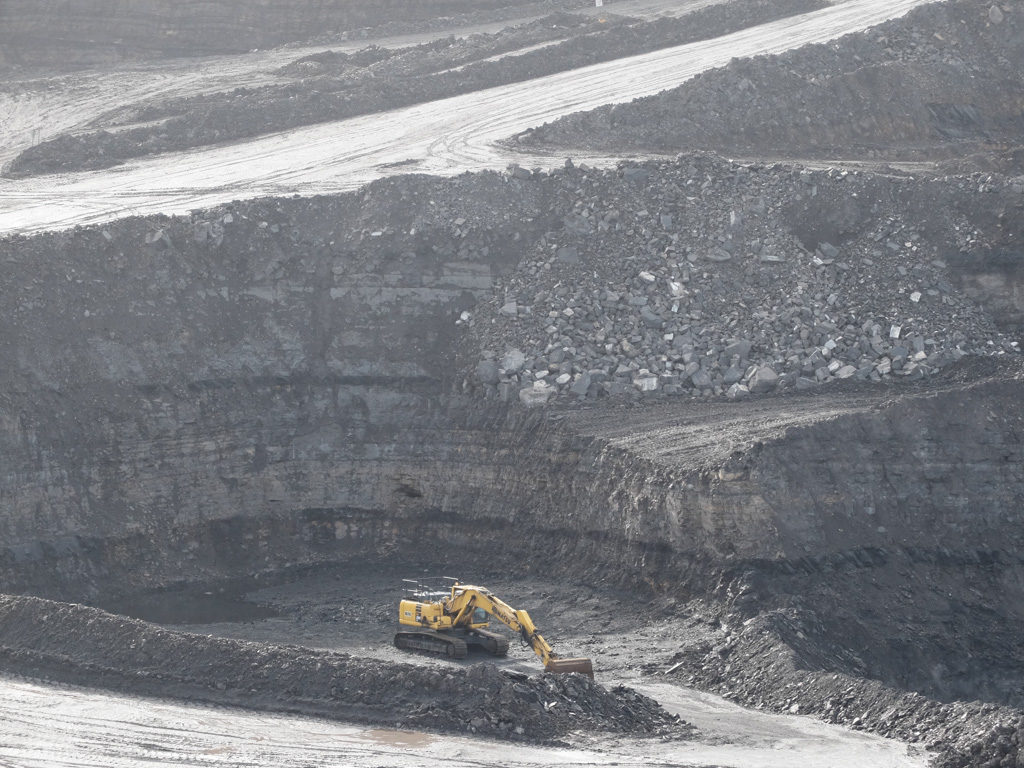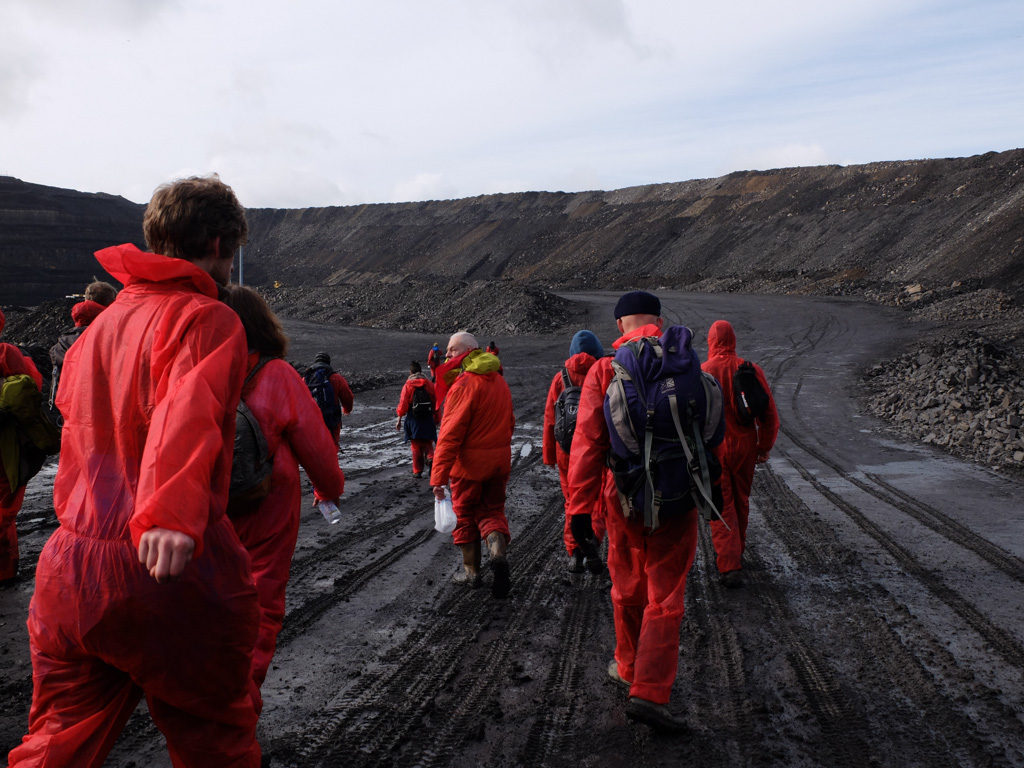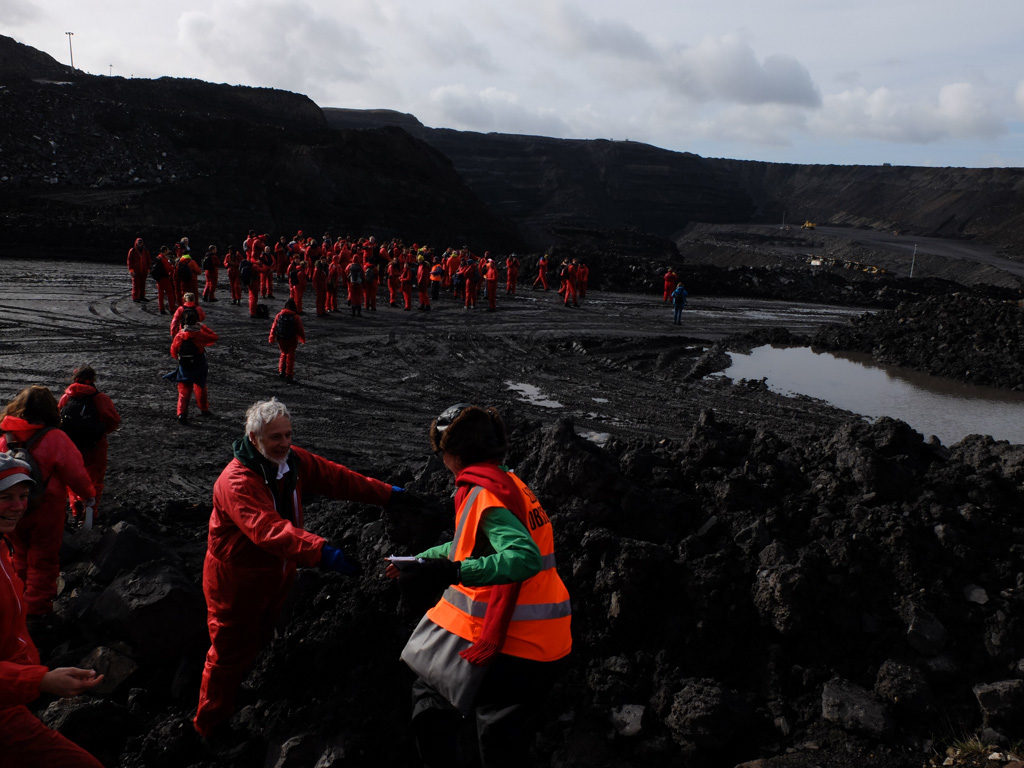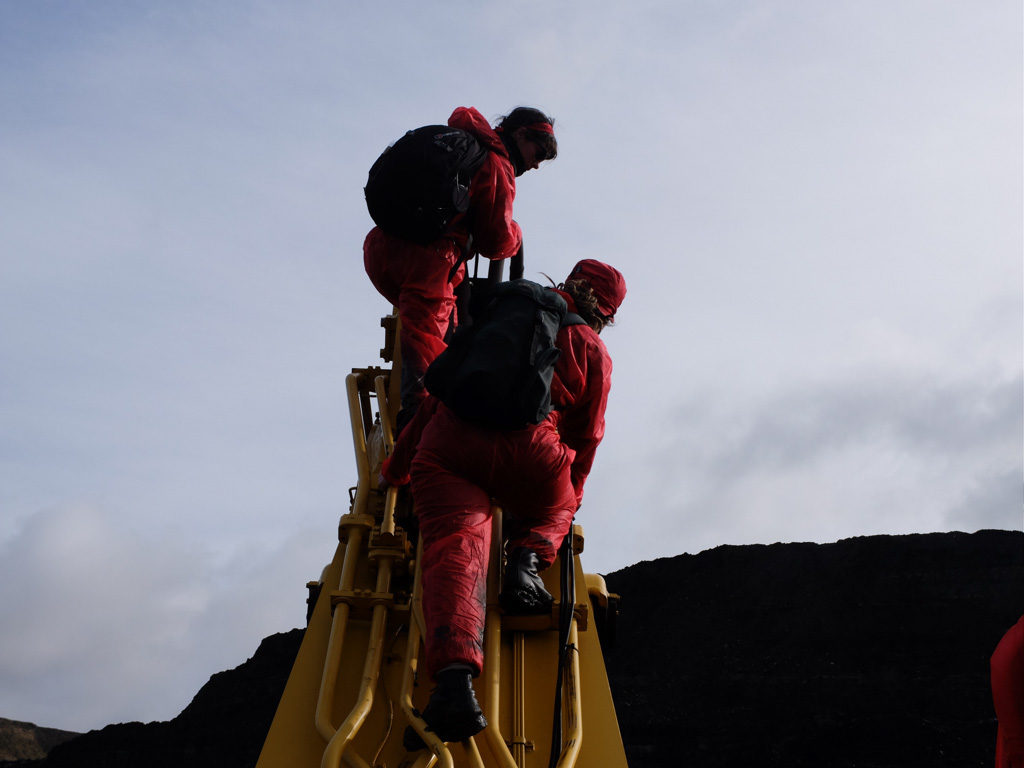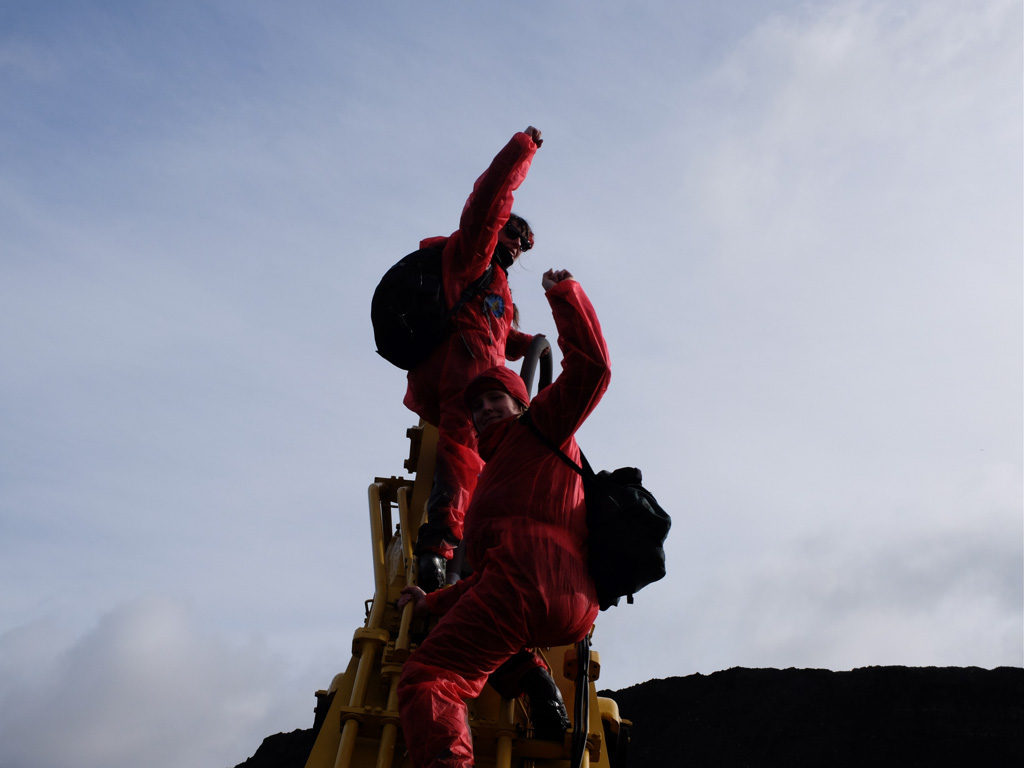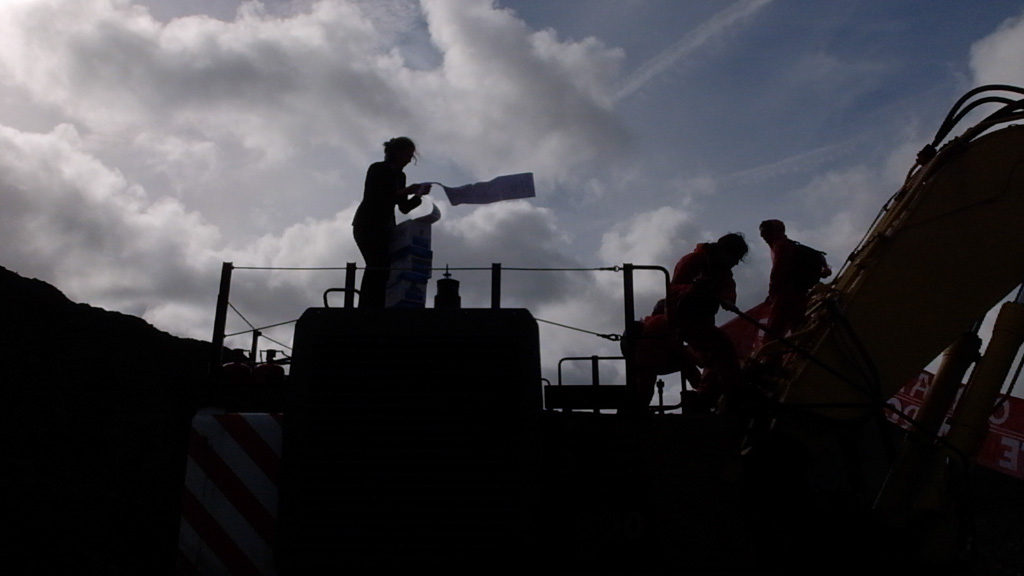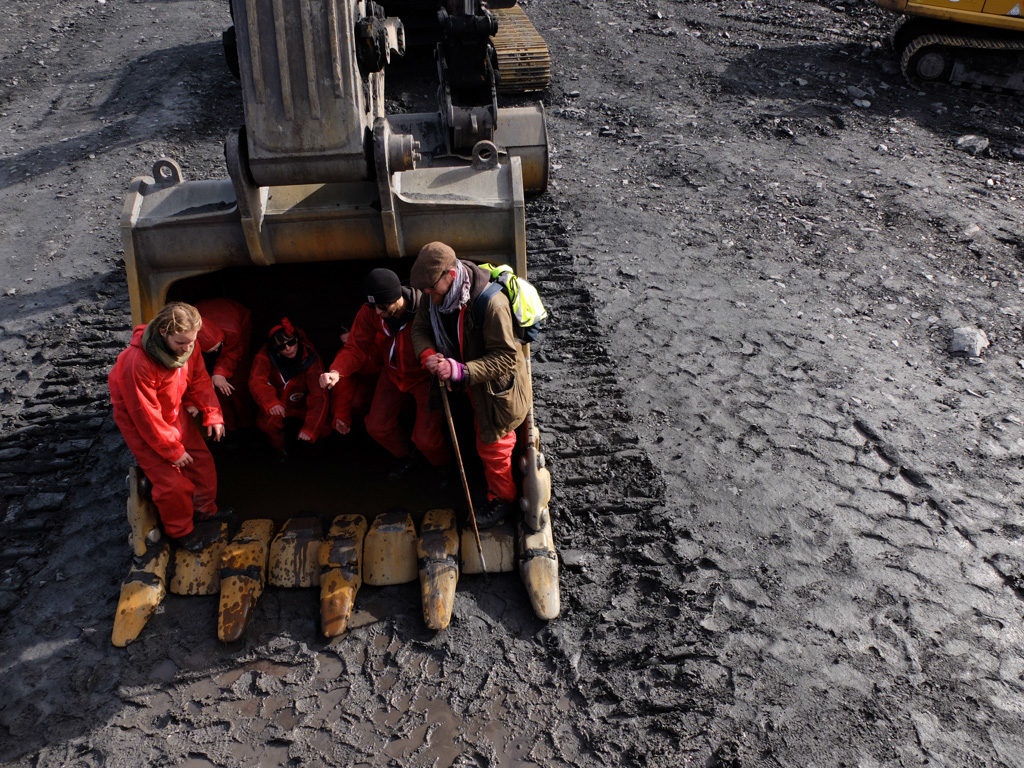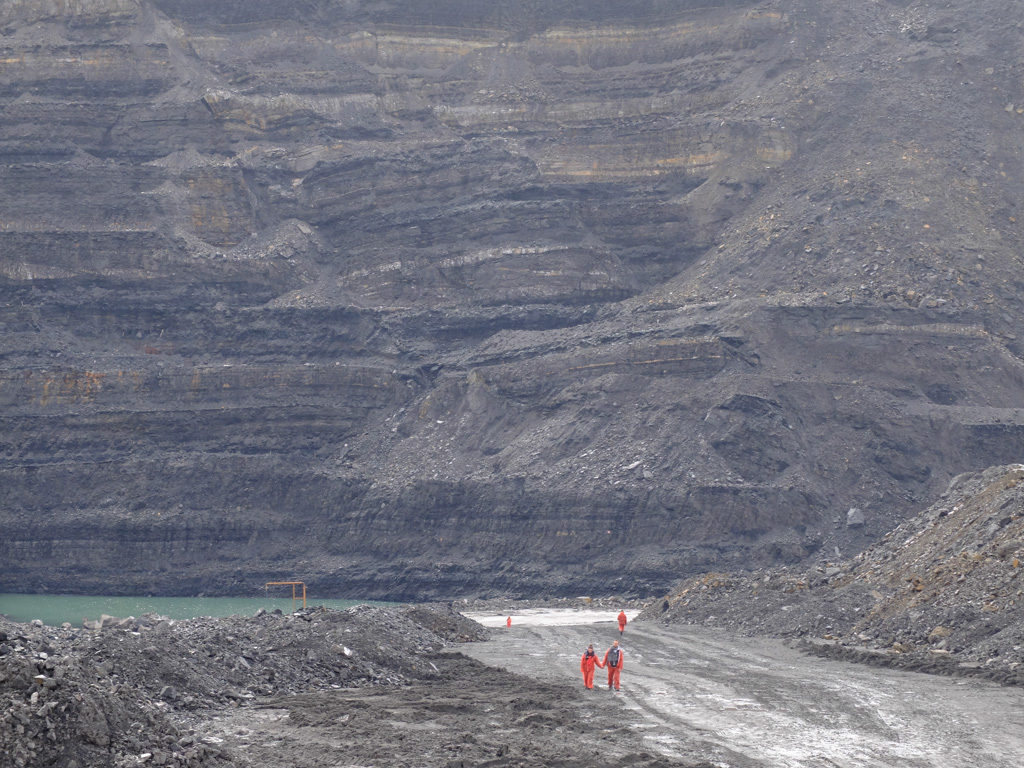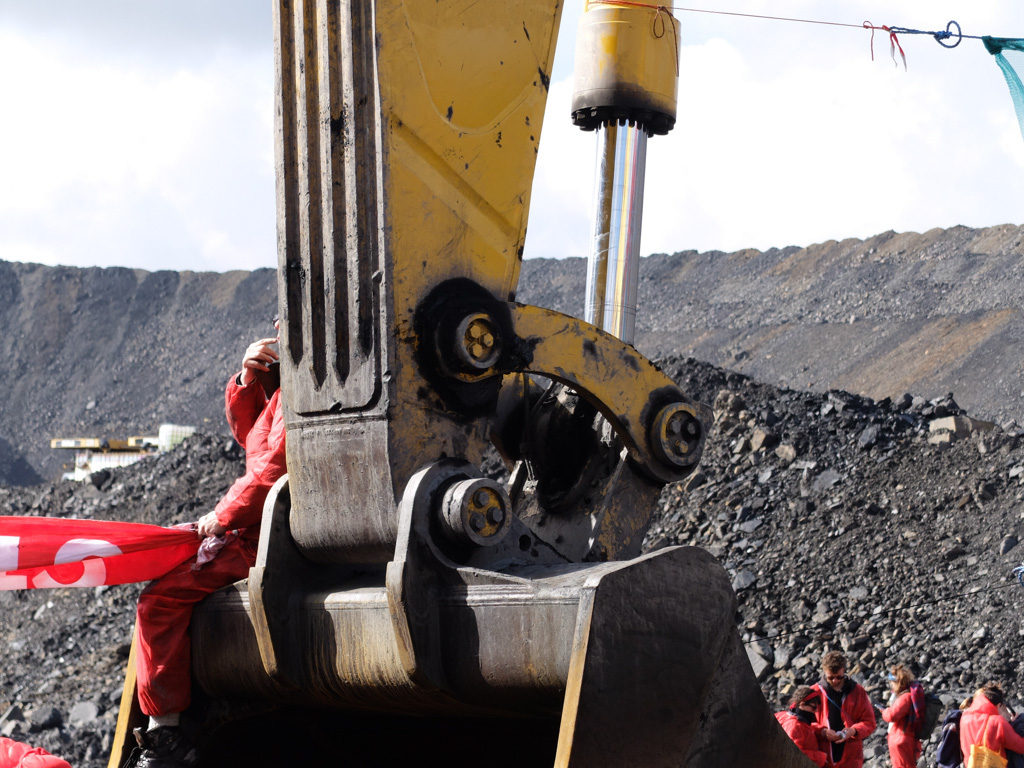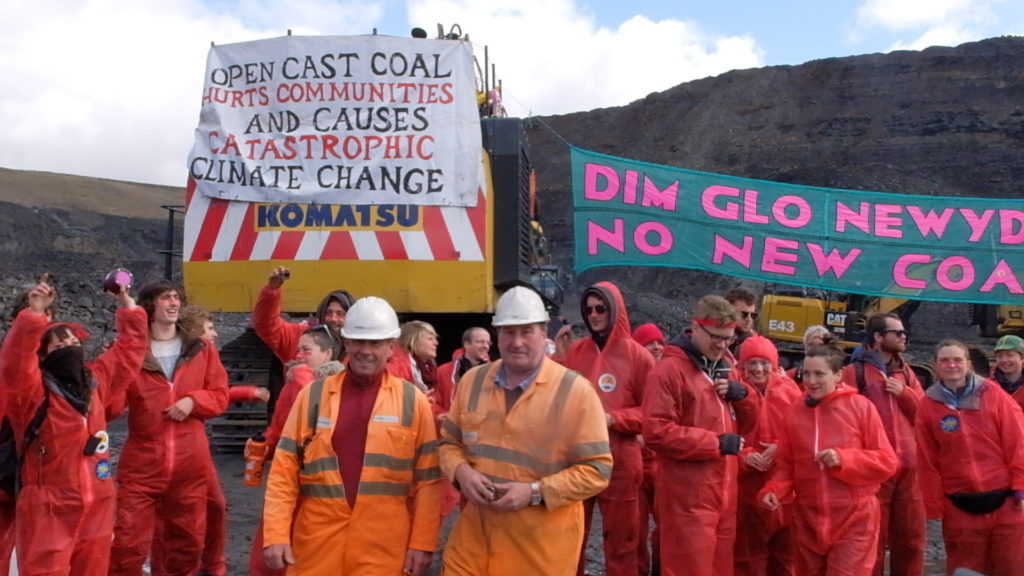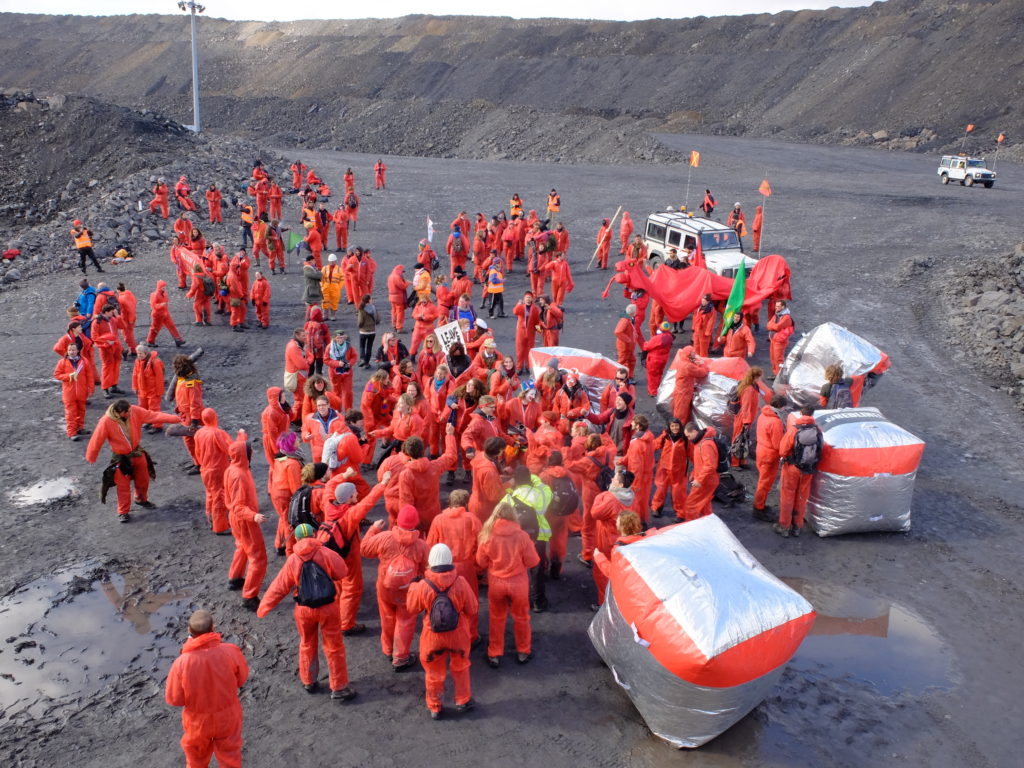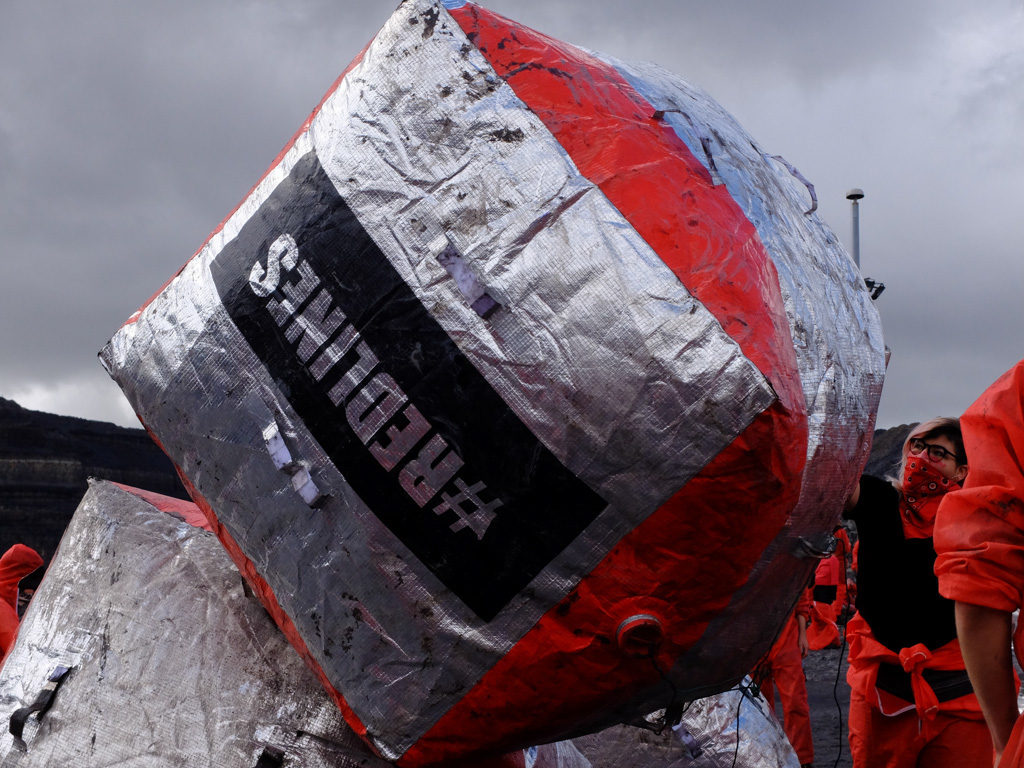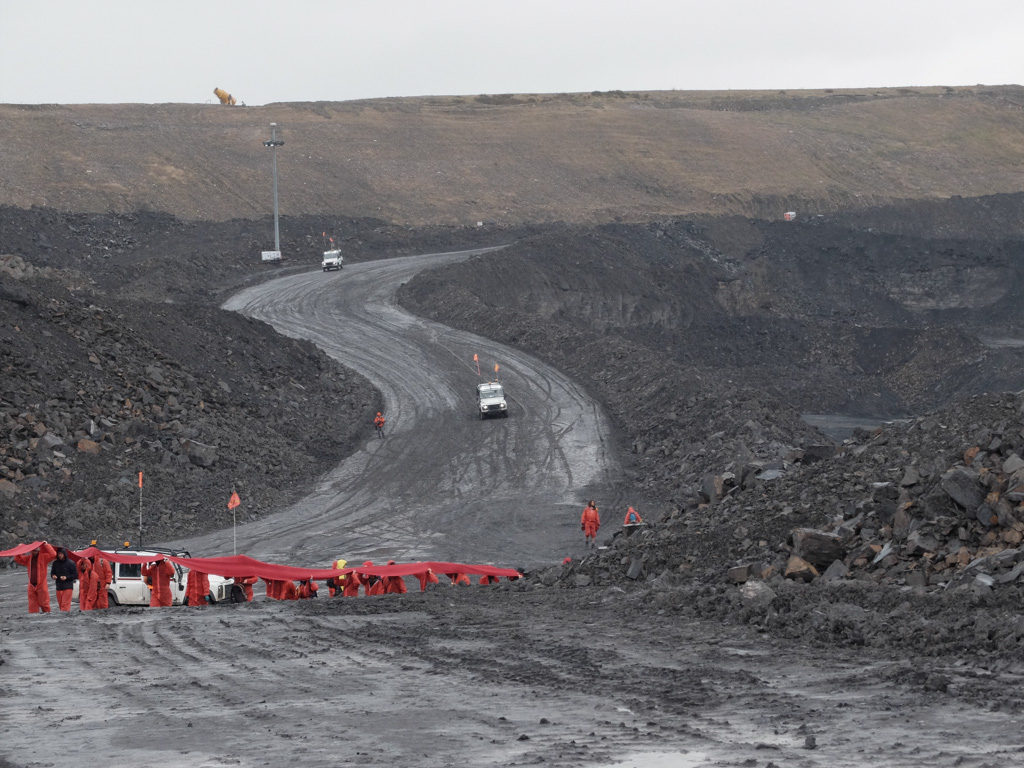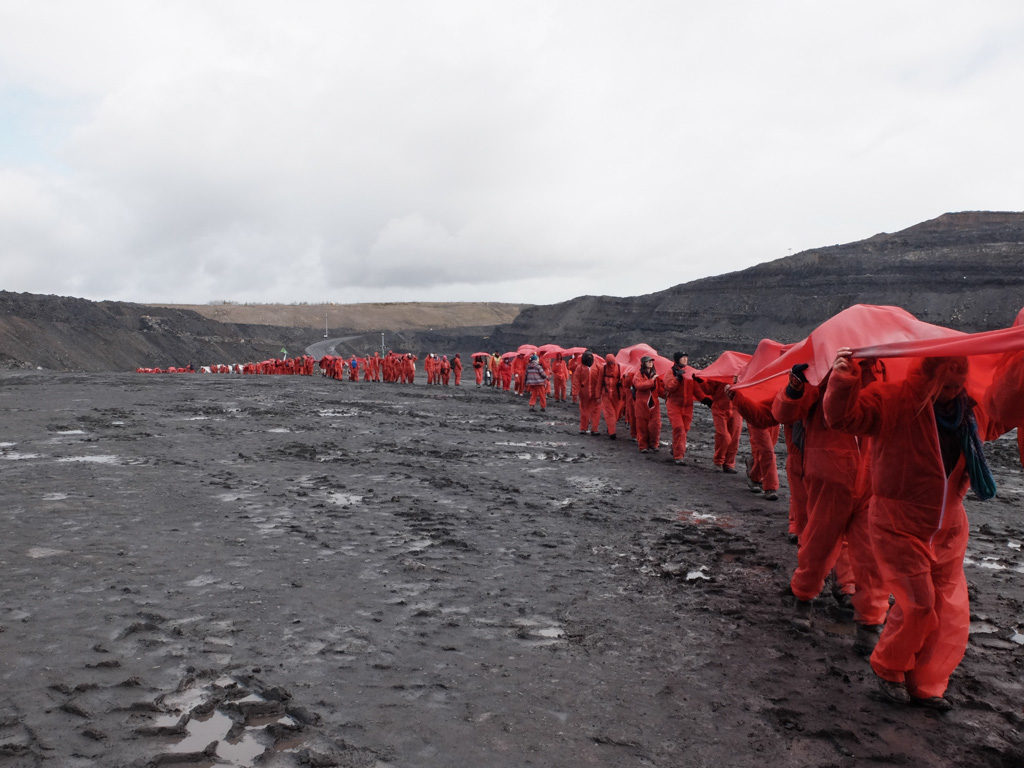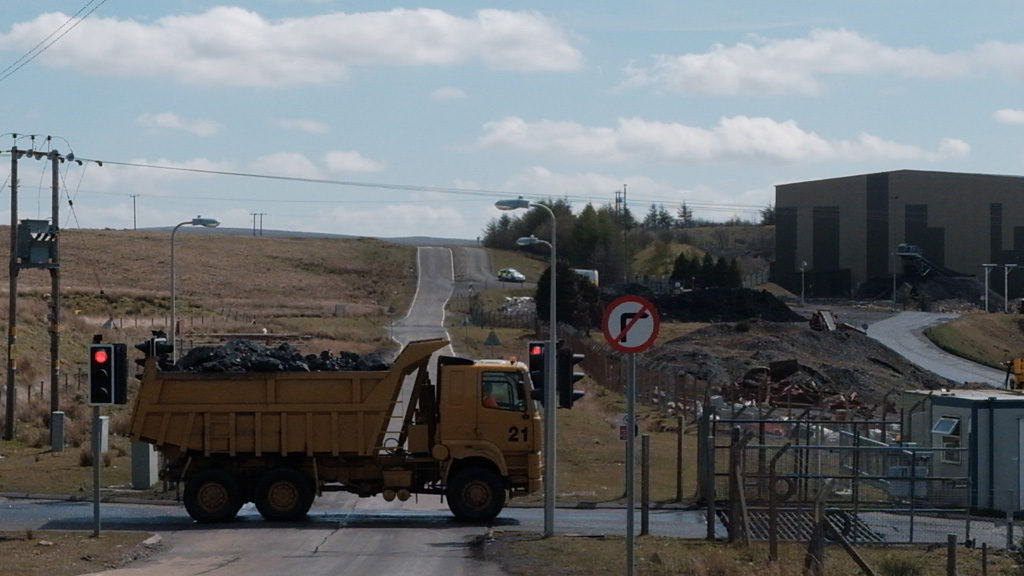by Aaron Vansintjan
(If you play the above video while reading the article, it can provide a nice soundtrack)
As we found out on May 3rd, 2016, coal comes in a variety of shapes, textures, and sizes. Yes, we had “invaded” an open-cast coal mine for the sake of the climate, we were calling for a more just economic system that is not based on extraction, exploitation, and pollution. But in the presence of this substance, we became children collecting shells and pebbles at the beach: we crawled on hands and knees, exclaimed “woah, look at all the layers!”, placed them gently in bags to give to our friends later.
Holding a chunk of coal in my hand, I thought: this is the stuff. This is what they want. This brittle, dark substance powers my computer, lights my living room, and makes our modern livelihood possible. This opaque matter, which sucks in all the light around it, has stood at the center of social and environmental struggles for the last two centuries. It has powered science and innovation, fueled wars, and helped build the cities we live in. These thoughts imbued the coal I was holding with a sort of enchantment, inspired a reverence I had not felt before.
I thought: this is the stuff. This is what they want. This brittle, dark substance powers my computer, lights my living room, and makes our modern livelihood possible.
Ffos-y-fran, the United Kingdom’s largest open-cast coal mine, is nestled in the hills just outside of Merthyr Tydfil, a Welsh community of just 65,000 people. Miller Argent, the owner of the mine, employs 200 people and has dug up 5 million tonnes of award-winning coal, and intends to extract 11 million tonnes more.
For decades, the community has resisted the coal mine, complaining about the proximity of the mine, pollution of their ground water and air, the noise from explosives, and that it’s really, really ugly. While the community was in favor of deepcast mining—which involves less visible impact on the environment and will often employ local residents—open-cast mining employs far less people, most of whom are specialized in operating specific machinery and will move on once the mine is exhausted. In 2007 Miller Argent proposed to start another site nearby. Once again, the community resisted.
Reclaim the Power (RTP) is a decentralized network of climate justice activists—they organize without central leadership, coming together for strategic actions to block further development of the fossil fuel economy in the United Kingdom. As part of a two-week global wave of actions against fossil fuels, RTP organized their largest action yet: to invade a coal mine and shut it down for a day, symbolically highlighting the need to shift to a more just, fossil fuel-free economy.
Working with some amazing local activists, the United Valleys Action Group, RTP meticulously planned a campsite with the facilities to support hundreds of people (food, water, even composting toilets), orchestrated a massive media campaign, and even used the opportunity to host workshops, art-making, and dance parties. The result was beyond a direct action: it involved celebration, education, and politicization.
At several points during the action, I heard people remark, “what matters is how this appears in the media”, or, “this is useless if it’s not covered in the news.” Now, a week after the action, I want to reflect, not on its media impact, not on its success or failure—all important concerns. Very simply, I’d like to tell the story of what it’s like to be in a coal mine, explore it, and play with its terrain.
Unearthing the logic of the mine
“In a dérive one or more persons during a certain period drop their relations, their work and leisure activities, and all their other usual motives for movement and action, and let themselves be drawn by the attractions of the terrain and the encounters they find there. Chance is a less important factor in this activity than one might think: from a dérive point of view cities have psychogeographical contours, with constant currents, fixed points and vortexes that strongly discourage entry into or exit from certain zones.”
-Guy Debord, “Theory of the dérive”
The Situationists argued that the alienation workers felt in the factory had extended to every aspect of modern life. Our cities have become depoliticized, commodified spaces primarily geared toward profit and social isolation.
To confront this, they developed tactics—games—that could repurpose the city and allow them to engage with it differently. To them, understanding how the city shapes our daily lives was paramount in overcoming alienation from our environment, and breaking down isolation between each other.
If the city is the site of our daily alienation, then the coal mine is its engine.
One of these games was the “dérive”, meaning “drift”, where a small group of people would navigate the city, letting its landscape and terrain guide their movements. This would allow them to come to new conclusions about their city and pin-point ways to counteract its commodification and estrangement.
If the city is the site of our daily alienation, then the coal mine is its engine. The growth of modern urban life is inseparable from the extraction of coal. London first outmatched Amsterdam economically when the peasantry, displaced from their land, were forced to work in the coal mines. Coal powered the textile mills and food processing factories, which in turn enabled the cotton and sugarcane industries, fueled by slave labor, to flourish in the Americas. Coal kick-started a new world order, just as it continues to be a key ingredient for the industrial development of East Asian countries today.
Since the 1960s—when the Situationists were most active—the world has globalized and urbanized. We are now faced with what geographers call “planetary urbanization”—in which even the “countryside” has been shaped in the likeness of, and for the purpose of, growing megacities, and it has become difficult to say exactly where the city begins and ends. Now, all types of terrains and landscapes have been transformed into an interconnected mesh, a standing reserve of resources, extractive flows, and sites of commodified value.
The coal mine is an essential component of urbanization, and a great place for a dérive.
So why not think of the action at Foss-y-fran as a mass dérive? The organizers realized this: one affinity group dragged around giant inflatable “cobblestones”—a direct and conscious reference to the Paris May ’68 slogan “under the cobblestones, the beach”. The slogan recalled the cobblestones lifted by students to throw at police and create barricades with, but it also suggested that capital could be subverted by engaging with your surroundings in new ways.
It was this sense of play that many brought to the coal mine. When we arrived at the mine, there was a moment of wonder, excitement. This required weaving our way past giant mounds of slag that had been “reclaimed”—in other words, they grew some grass on top of it and allowed sheep to graze on them. But once past these, we entered a different world: everything around us was black and grey, muddy, gritty. Tall cliffs surrounded us on all sides, and nestled in their shadows were a handful of massive yellow machines—the diggers and the trucks.
The access roads were made for and by these machines. We were told to be careful of the smaller heaps of slag on each side: these could collapse and endanger others below. Finally, we found ourselves in the belly of the beast: the place where coal was being actively mined.
Here we were, in the hundreds, in a landscape not intended for pedestrians, let alone crowds. It was no accident, then, that we tended to gravitate toward the large machines that shaped this landscape. We quickly climbed up them and appropriated them with our slogans and games.
If you string a banner—“NO NEW COAL”—between two large diggers, you can play a game of volleyball with the “cobblestones”. The arm of the digger—just over two meters long—creates a hollow space ideal for amplifying a portable sound-system. When it rains, several dozen people can hide under a digger and start a mini-rave.
Once the initial excitement receded, we took strolls around the site, picking up rocks, inspecting deep pools of water, clambering up ledges. At one point, we stopped in front of a steep cliff. From a crevice in the layers of rock bubbled a tiny stream, staining the rock around it with a bright, rusty red. Even within this site dedicated to excavation, wildness still found a way to seep through the cracks. Amongst several people that I talked to, there was an appreciation for this landscape that I hadn’t expected: we agreed that there was something sublime about it.
Activists are often worried about whether their direct actions really “make an impact” or “succeed”. At meetings in London I attended in the past year, people would often suggest that community-based (“local”) organizing was less effective than orchestrating a large media presence and announcing clear, attainable demands, achieved through mass movements with precise political platforms. I’ve heard people criticize temporary occupations because they fail to scale up beyond the local, and, without institutionalized resistance or well-defined goals, they are unable to address the root of our problems.
The action at Ffos-y-Fran was highly temporary in nature: a day later, the mine was operating perfectly, without a hitch. It did not change any government policies, nor did participants articulate a coherent policy platform. What’s more, for every coal mine shut down in the UK, there are ten new ones in China, Vietnam, and Australia.
But is this how we want to define success? Ende Gelaende, the Germany-based anti-coal group whose invasion of a German coal mine last year inspired the Ffos-y-Fran action, loudly proclaim: “we are the investment risk!” The joke is that activists are happy to speak in the language that the fossil fuel companies use. Today they are at it again, with 3,000 people occupying the largest coal mine in Europe.
But the joke is double-sided: they are also poking fun at that very same language. It acknowledges that success cannot just be defined according to the language of the status quo. If all we mean by success is a good media presence, divestment of stocks, or a shift in government policy, then anything that does not look like that is ignored.
If you measure success according to statist, market-based goals, you will miss the non-statist, non-market activity that lurks underneath the action.
In his book Territories in Resistance, Raúl Zibechi argues that blockades and spontaneous actions have much deeper roots and are less fragmented than they seem. Rather than measuring their success in terms of whether they were able to change the state structure, he instead sees them as “lightning illuminating the night sky”: the direct action is just the more visible part of much larger, non-institutionalized movements that are already creating a new world within, and outside of, the old.
How about this for success: for a whole day, 300 of the UK’s most active climate justice activists got the chance to be inside of a coal mine, to understand its logic, and to get a feel for what is one of the most integral cogs to the current economy. For a day, adults became children, they turned machines into playgrounds, and they formed new relationships with each other.
How about this for success: for a whole day, 300 of the UK’s most active climate justice activists got the chance to be inside of a coal mine, to understand its logic, and to get a feel for what is one of the most integral cogs to the current economy.
If you measure success according to statist, market-based goals, you will miss the non-statist, non-market activity that lurks underneath the action. You will miss the heaps of dishes, the hours of meetings, the work put into making food. You will miss the crucial elements of a new type of movement that sees cooking, cleaning, playing, and caring as forms of resistance. These elements are busy rehearsing new ways of doing things, new types of economies.
The nature of the dérive is open-ended: it requires a kind of receptivity to new experiences, to new realizations. In return, it provides fresh insight into the machinations of our world, it suggests strategic weak points that may have not been visible before. If we are to resist today’s economy and plan for a new one, we cannot allow the elite to define success for us. Just as we must imagine new worlds, we must learn to create life and play in the ruins of the old.
Lifting the spell
The action was nearing its end. By 2 p.m., many of us were getting tired, others were just anxious to move out of the site we had occupied for the past five hours.
As a group, we decided that some of us would guard the diggers, which had become so familiar to us, and others would go explore the rest of the mines and try to stop the works that were happening elsewhere.
On the way there, we were met with a convoy of white Land Rovers filled with roughly 80 fully-outfitted riot police. They gave us two minutes to leave the premises. Now about 70 ourselves, we gathered in a circle to make a quick decision. I split off from the group with about fifteen others—not wanting to risk arrest at this point—and we made our way up another excavation site, which then curved around and over the hillside, finally leading us to the jagged edge of the mine.
The day had turned dark. I felt a bit like Frodo in Lord of the Rings: in the very guts of Mount Doom, my thoughts transformed by the landscape, all willpower receding in face of the challenge ahead of me.
When I reached the edge, I felt a thick layer of moss under my feet and saw the rolling Welsh hills in front of me. I collapsed onto the green ground. All of a sudden the dark spell was lifted. The massive black coal pit, at one point so impressive, had shaped my mood, and it gave the impression that there was no escape. Hugging the moss, I realized the extent to which the mine had clouded my judgements, and knew that it could no longer affect me.
From this edge we could see the events unfolding below us. A group of activists stood aside from the police, who, having left their vehicles, marched in impressive formation down the road, toward the deepest part of the mine, toward those who were guarding the diggers. We stayed at this look-out spot for about an hour, sharing snacks, talking about the day, and observing the show-down between the police and the handful of activists that remained.
It was at that point that the action was mostly over. It would take about two more hours for everyone else to leave. Some successfully stopped activity in other parts of the mine. Others chained themselves to the diggers. No arrests were made. In groups, we arrived back in camp, and were met with a warm welcome from those who had stayed behind.
A couple of minutes outside of the camp, a red traffic light obstructed my path. An endless supply of trucks, loaded high with coal, rolled out of the mine. Business as usual.
The next day, I set off back to the city. A couple of minutes outside of the camp, a red traffic light obstructed my path. An endless supply of trucks, loaded high with coal, rolled out from the mine. Business as usual. It seemed like yesterday was an illusion, a trip into the Kingdom of Narnia. Waiting for the light to change, I reached into my pocket and my fingers found a small rock. I took it out and looked at it: it was black, the size of a coin. It glinted in the sun. The traffic light turned green, and I put the piece of coal back into my pocket.
Postscript: lessons learned
If our action was like a “dérive”, I’d like to contribute three small notes to its methodology, none of them particularly new but each reinforced by my experiences of the action.
First, the structure of the “affinity group”—developed by activists to maintain autonomy and decentralization within actions, while ensuring trust and cohesion among the participants—is also useful for drifting through the terrain of the coal mine. Guy Debord notes that a dérive works best when capped at 2-4 participants. We could say that the affinity group, which tends to be comprised of 2-10 people, and will often be broken down into “buddy groups” of 2-3 people, makes it possible to conduct a dérive en masse.
Second, anonymity—upheld by activists in these kinds of actions for fear of surveillance and political persecution—is a double-edged sword. Paranoia inhibited trust between us, deflating some of the potential for making connections with others and multiplying strong bonds. It also inhibited some from being more outgoing and honest in their opinions, and created a hierarchy between long-time activists who knew and trusted each other and newcomers, like myself. Then again, the necessity of anonymity in the action led to a new experiential relationship for those who didn’t already know each other: who a person is was stressed less than the interactions you have with them. In these fleeting interactions, you were judged by your immediate acts and not by your ideas, past, political stance, etc. Kind of like at a party—a mass trespassing party.
Third, problems of exclusivity and ableism were apparent throughout the action. I met an older man who was almost in tears because he had been excluded systematically. Whenever he had tried to join an affinity group, people turned away or stopped talking. As a result, he didn’t feel comfortable joining in the day of the occupation. His way of speaking and interacting was unusual, and I thought that many of these activists might have been uncomfortable engaging with someone who seemed like he was mentally unstable.
In addition, one of the participants of the action used a wheelchair, and she constantly had to assert herself to make the action accessible to her. At one point, some people in her affinity group accompanied her to observe the edge of the mine: doing this could be seen, not as an inconvenience, but as an extremely radical action. It challenges both the world shaped by and for machines and the often inaccessible world of activist actions.
If an action is based on trust, it also means that the dominant group will define who is “trustworthy”, and not being member of that group or having mental health issues may increase the chance of not being trusted. Similarly, if an action is organized by mostly able, white folks, then the activities will likely feel alienating to those not part of those demographics, and they will need to work so much harder to be involved. A dérive can be so much more instructive if people excluded by this alienating, isolating society were to participate: they may be better equipped than anyone else to notice the weak points in the oppressive terrain.
All photos and videos by Aaron Vansintjan except for #17 (of the feet under the digger), which was taken by Anonymous.
Aaron Vansintjan studies ecological economics, food systems, and urban change. He is co-editor at Uneven Earth and enjoys journalism, wild fermentations, decolonization, and long bicycle rides.
To receive our next article by email, click here.
